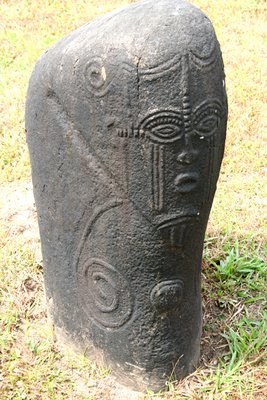Ikom monoliths
 At Ikom, in the North of Cross River State, there is a mysterious circle of stones known as the Ikom monoliths, right on the border with Cameroun. They have moved one to the grounds of the Calabar museum. The stones have been dated at 200AD, but may be older. About 3 feet high, the design on the front is extraordinarily beautiful. We must be thankful the British didn't find them in time to steal them away to the British Museum and keep them locked in some dingy basement. My tour guide tells me they have found similarities between one of the nearby local languages and the language spoken by the Ancient Egyptians.. One thing is sure, one of the main ethnic groups in the State, the Efik, migrated over 500 years ago from Sudan, so there may just be a link with Nilotic cultures..
At Ikom, in the North of Cross River State, there is a mysterious circle of stones known as the Ikom monoliths, right on the border with Cameroun. They have moved one to the grounds of the Calabar museum. The stones have been dated at 200AD, but may be older. About 3 feet high, the design on the front is extraordinarily beautiful. We must be thankful the British didn't find them in time to steal them away to the British Museum and keep them locked in some dingy basement. My tour guide tells me they have found similarities between one of the nearby local languages and the language spoken by the Ancient Egyptians.. One thing is sure, one of the main ethnic groups in the State, the Efik, migrated over 500 years ago from Sudan, so there may just be a link with Nilotic cultures..
The Efik were also middlemen who profited hugely during the slave trade. The tourist guide laughed sheepishly when I asked her about this..



5 comments:
I thank you for all these pictures and opening my eyes to a Nigeria that I did not know existed. It's so pleasing to see the facets of our patchwork country. But for you I would not have known about all these things. When next I am in Nigeria [God willing that would be soon] I will be sure to travel, just so that I can maybe take pictures as fantastic as these one you have taken
Thank you for this beautiful pictures of our monoliths. Growing up as a child in Ikom was quite a facinating experience. The documentation of our historical symbolised by these artifats and other acheological findings would have been richer but for ignorance and iliteracy. We grew up regarding the monoliths as representations of deities. Some were destroyed and many stolen away by those who had early contacts with collectors who paid them paltry sums. We were also told that some of the monolith "theives" died mysteriously in the process of trading with some "white men". At the back of our house in No 5 Rilley Street in Ikom Town, I remember vividly how after one very rainy day I found jugs, teacups, cowries, mugs and many other items that were escavated. My father told me in those days such items were properties that were buried with the dead. I cannot tell where those items were kept, perhaps this would would have served as clues to another part of the rich cultural history of the Ikom people in Cross River State. LIEUTENANT GODWIN NDIFON NDIFON
I really appreciate the pics of Ikom monoliths.However,there are serious threats to the monoliths according to http://wmf.org/watch2008/watch.php?id=S8540.The threats are majorly environmental.The local, regional and federal governments recognize the importance of preserving the monoliths.Nevertheless,limited resources have been the greatest impediments
I really appreciate the pics of Ikom monoliths.However,there are serious threats to the monoliths according to http://wmf.org/watch2008/watch.php?id=S8540.The threats are majorly environmental.The local, regional and federal governments recognize the importance of preserving the monoliths.Nevertheless,limited resources have been the greatest impediments
I am Professor Catherine Acholonu. I lead the team of researchers who have been studying the Monoliths of Ikom since 2001 while I was the Special Adviser on Arts and Culture to the Nigerian President. It was thanks to our work and submissions that the monoliths are now listed by the WMF as one of the world's 100 most endangered sites in the year 2008. That publication says that the monoliths are a lost form of writing dating before 2,000 B.C, and not 200 AD, please. We have a 500-page book (The Gram Code of African Adam, www.carcariculture.org) on our findings, and it is due to these published findings of ours that it is now known that the inscriptions on the monoliths were writings, and that they have similarities with, and even precede Sumerian Cuneiform and Egyptian hieroglyhics. Our new book - The Lost Testament - shows evidence of their similarities with Middle Eastern writing-systems. For example the spiral you are looking at on the monolith is a letter in many ancient languages. Question is - Who taught whom? Our works provide the shocking answers....
Post a Comment